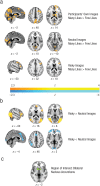The Power of the Like in Adolescence: Effects of Peer Influence on Neural and Behavioral Responses to Social Media
- PMID: 27247125
- PMCID: PMC5387999
- DOI: 10.1177/0956797616645673
The Power of the Like in Adolescence: Effects of Peer Influence on Neural and Behavioral Responses to Social Media
Abstract
We investigated a unique way in which adolescent peer influence occurs on social media. We developed a novel functional MRI (fMRI) paradigm to simulate Instagram, a popular social photo-sharing tool, and measured adolescents' behavioral and neural responses to likes, a quantifiable form of social endorsement and potential source of peer influence. Adolescents underwent fMRI while viewing photos ostensibly submitted to Instagram. They were more likely to like photos depicted with many likes than photos with few likes; this finding showed the influence of virtual peer endorsement and held for both neutral photos and photos of risky behaviors (e.g., drinking, smoking). Viewing photos with many (compared with few) likes was associated with greater activity in neural regions implicated in reward processing, social cognition, imitation, and attention. Furthermore, when adolescents viewed risky photos (as opposed to neutral photos), activation in the cognitive-control network decreased. These findings highlight possible mechanisms underlying peer influence during adolescence.
Keywords: adolescent development; neuroimaging; open materials; risk taking; social cognition; social influences.
© The Author(s) 2016.
Conflict of interest statement
Figures


References
-
- Baird A. A. (2012). The terrible twelves. InZelazo P. D., Chandler M., Crone E. (Eds.), Developmental social cognitive neuroscience (pp. 191–207). New York, NY: Psychology Press.
-
- Blakemore S. J., Mills K. L. (2014). Is adolescence a sensitive period for sociocultural processing? Annual Review of Psychology, 65, 187–207. - PubMed
-
- Blasi G., Goldberg T. E., Weickert T., Das S., Kohn P., Zoltick B., . . . Mattay V. S. (2006). Brain regions underlying response inhibition and interference monitoring and suppression. European Journal of Neuroscience, 23, 1658–1664. - PubMed
Publication types
MeSH terms
Grants and funding
LinkOut - more resources
Full Text Sources
Other Literature Sources
Medical

